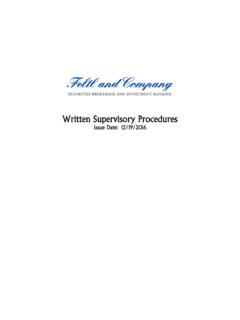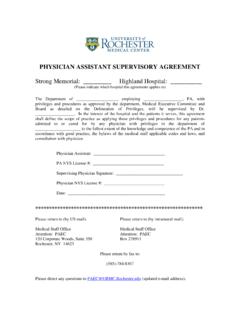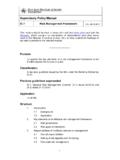Transcription of ECB comprehensive risk assessment: single …
1 ECB comprehensive risk assessment : single supervisory mechanism The European Central Bank (ECB) has released a paper setting out the approach to be taken for a comprehensive assessment of the health of the eurozone banking The assessment will cover 130 banks in 18 eurozone Member States representing 85% of euro-area bank assets. This assessment will be carried out prior to the ECB assuming its new supervisory role in November 2014, as part of the creation of the single supervisory mechanism (SSM) for eurozone banks. The comprehensive assessment will conclude in October 2014. The banks covered by the comprehensive assessment will be those that are directly supervised by the ECB. The SSM legislation gives the ECB the power to obtain all the necessary information from the national supervisors, referred to as national competent authorities (NCAs), to enable the comprehensive assessment to be made. The assessment will have three parts: A supervisory risk assessment An asset quality review A stress test The outcome from all three parts will influence the actions taken to address any revealed weaknesses.
2 Such measures may include the requirement to raise provisions or capital levels, among other possible responses. 1 European Central Bank, Note: comprehensive assessment , October 2013. Global Regulatory Network Executive Briefing Global Regulatory Network Global Stefan Walter Americas Don Vangel Marc Saidenberg EMEIA Patricia Jackson Thomas Huertas John Liver Urs Bischof Marie-H l ne Fortesa Asia Pacific Keith Pogson Phil Rodd David Scott Japan Hidekatsu Koishihara November 2013 Global Regulatory Network Executive Briefing 2 Approach The ECB will lead the exercise by setting out the detailed design and strategy and by monitoring its execution, as well as consolidating and disclosing the results. Under the ECB s strong oversight, the NCAs will execute the exercise at a national level. Both the ECB and NCAs will use private sector experts to support their assessments. The comprehensive assessment has three pillars: supervisory risk assessment covering key risks that include liquidity, leverage and funding risk.
3 The assessment will encompass quantitative analysis, both backward- and forward-looking, as well as an assessment of a bank s position relative to its peers and its vulnerability to exogenous factors. The ECB and NCAs are developing a new risk assessment system that will be a key tool in the future SSM. Asset quality review examining assets as of 31 December 2013. This will cover credit and market risk exposures, including a quantitative and qualitative review of hard-to-value assets and on- and off-balance-sheet positions. The review will also consider nonperforming assets and forbearance. This entails breaking open loan files, assessing collateral valuations and looking at lending standards and provisioning. Stress test building upon and complementing the asset quality review by providing a forward view of a bank s loss-absorbing capacity in the face of severe economic and financial shocks. The ECB and European Banking Authority (EBA) have agreed to perform the next European Union-wide stress test in close cooperation.
4 Capital threshold A capital threshold will be set as a benchmark for assessing the outcomes of the exercise. The threshold will be 8% Common Equity Tier 1 using the capital definition as of 1 January 2014. However, the stress test will also have to take into account the definition of Common Equity Tier 1 capital in force at the end of the stress test period because the Basel III phase-in requirements will lead to a gradual tightening of the definition of capital over this period. Follow-up actions Significant weaknesses identified in the comprehensive assessment will lead to supervisory follow-up actions, such as recapitalization (through profit retention and/or new equity), a change in the funding profile or an increase in provisioning. Implications This is the most comprehensive assessment of the strength of the eurozone s major banks ever to be conducted on such a scale, although some peripheral countries have already carried out one or more asset quality reviews.
5 A key question is what the available backstop provisions will be should there be capital shortfalls for some banks or banking systems. The ECB has made clear that any shortfalls should be made up from private sources of capital and, if these prove to be insufficient, public backstops might need to be drawn on. For additional information, please contact: Stefan Walter Global Regulatory Network Leader Patricia Jackson EMEIA Head of Financial Regulatory Advice Global Regulatory Network EY s Global Regulatory Network is an integral part of our Financial Services Office and enables EY to offer banks deep experience, leadership and insights on financial regulation. Our global regulatory services are led by an executive team of former senior regulators, including former Basel Committee Secretary General Stefan Walter. This team, supported by more than 100 other former regulators, drives EY s strategic outlook on global regulatory themes impacting global banks, including capital, liquidity, resolution and recovery planning, risk governance and other emerging topics in banking regulation.
6 Stefan Walter was secretary general of the Basel Committee on Banking Supervision from 2006 to 2011. During this time, he was also a member of the Financial Stability Board. He has more than 20 years of international bank supervisory experience, including 15 years at the Federal Reserve Bank of New York. Dr. Tom Huertas is a former member of the FSA s Executive Committee. He also served as alternate chair of the European Banking Authority, as a member of the Basel Committee on Banking Supervision and as a member of the Resolution Steering Committee at the Financial Stability Board. Patricia Jackson is the former head of the Bank of England Regulatory Policy. She was the head of the Financial Industry and Regulation Division from 1995 to 2003 and was a member of the Basel Committee from 1995 to 2003. She chaired the global Quantitative Impact Studies to test the effect of Basel II and chaired the Calibration subgroup. Don Vangel, Regulatory Advisor to the Office of the Chairman, joined EY after a 17-year career at the Federal Reserve Bank of New York, where he ultimately served as a Senior Vice President for Bank Supervision.
7 Marc Saidenberg was a senior vice president and director of supervisory policy at the FRB of New York. He also represented the bank on the Basel Committee and served as co-chair of the committee s Working Group on Liquidity. He was actively involved in the development of the Basel III capital and liquidity standards, supervisory expectations for capital planning, liquidity risk management and RRPs. Urs Bischof is the former head of Risk Management of the Extended Executive Board of Switzerland s FINMA. His responsibilities included risk management supervision and oversight and prudential regulations, along with leadership roles with respect to Basel III, SIFI regulation, payments and clearing. Marie-H l ne Fortesa has extensive regulatory experience. Her posts have included leadership roles at the Autorit de Contr le Prudentiel (French Prudential supervisory Authority), the Association Fran aise des Banques (French Banking Association) and INSEE (French National Institute for Statistics and Economic Studies), as well as senior roles at a leading investment bank.
8 John Liver s experience includes a number of regulatory roles with leading investment banks as well as the UK FSA and its predecessors. His roles include head of thematic supervision in the Investment Firms Division, head of Personal Investment Authority Supervision, overseeing the sales regulation of the life and pensions industry, and management roles in Investment Management Regulatory Organization s Enforcement and Supervision Departments. Phil Rodd, Keith Pogson and David Scott have extensive experience working with regulators across the Asia-Pacific region. Hidekatsu Koishihara is a former chief inspector and inspection administrator for the Japan Financial Services Agency. He also worked at the Ministry of Finance of Japan (MOF), Japan s former financial regulator, serving as the financial inspector at the Bank Bureau of MOF and Financial Inspection Division, and Minister s Secretariat of MOF. EY | Assurance | Tax | Transactions | Advisory About EY EY is a global leader in assurance, tax, transaction and advisory services.
9 The insights and quality services we deliver help build trust and confidence in the capital markets and in economies the world over. We develop outstanding leaders who team to deliver on our promises to all of our stakeholders. In so doing, we play a critical role in building a better working world for our people, for our clients and for our communities. EY refers to the global organization and may refer to one or more of the member firms of Ernst & Young Global Limited, each of which is a separate legal entity. Ernst & Young Global Limited, a UK company limited by guarantee, does not provide services to clients. For more information about our organization, please visit 2013 EYGM Limited. All Rights Reserved. EYG no. XXXXXXX CSG/GSC2013/XXXXXXX ED MMYY This material has been prepared for general informational purposes only and is not intended to be relied upon as accounting, tax, or other professional advice. Please refer to your advisors for EY | Assurance | Tax | Transactions | Advisory About EY EY is a global leader in assurance, tax, transaction and advisory services.
10 The insights and quality services we deliver help build trust and confidence in the capital markets and in economies the world over. We develop outstanding leaders who team to deliver on our promises to all of our stakeholders. In so doing, we play a critical role in building a better working world for our people, for our clients and for our communities. EY refers to the global organization, and may refer to one or more, of the member firms of Ernst & Young Global Limited, each of which is a separate legal entity. Ernst & Young Global Limited, a UK company limited by guarantee, does not provide services to clients. For more information about our organization, please visit 2013 EYGM Limited. All Rights Reserved. EYG no. EK0216 1311-1164512 ED None This material has been prepared for general informational purposes only and is not intended to be relied upon as accounting, tax, or other professional advice. Please refer to your advisors for specific advice.
















